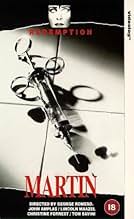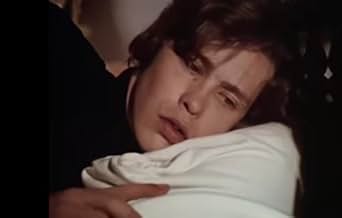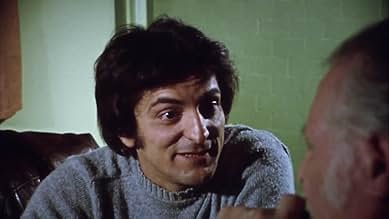A young man, who believes himself to be a vampire, goes to live with his elderly and hostile cousin in a small Pennsylvanian town, where he tries to suppress his blood-lust.A young man, who believes himself to be a vampire, goes to live with his elderly and hostile cousin in a small Pennsylvanian town, where he tries to suppress his blood-lust.A young man, who believes himself to be a vampire, goes to live with his elderly and hostile cousin in a small Pennsylvanian town, where he tries to suppress his blood-lust.
- Awards
- 1 win total
Francine Middleton
- Train Victim
- (as Fran Middleton)
Roger Caine
- Lewis
- (as Al Levitsky)
Donna Siegel
- Woman
- (as Donna Siegal)
- Director
- Writer
- All cast & crew
- Production, box office & more at IMDbPro
Featured reviews
Sometimes it seems to me that the "users" who comment on movies here go out of their way to miss the point. The horror storyline here isn't just "vampire nonsense" nor does Romero succeed in spite of his "lowbrow intentions." The film IS a horror film, as successful in "revising" the typical vampire films as other 1970's classics like McCabe and Mrs. Miller and Point Black were in "revising" the western and gangster genres respectively. The film would hardly be as interesting if it were some kind of slick production with the usual trappings. Instead Martin is a low-key intense underplayed film that reverses the usual expectations without rejecting its genre.
I don't think Romero is somehow upholding the ideals of faith either; the religious zealot, Martin's uncle, is the least sympathetic figure in the movie, though he may be right in thinking that Martin is "nosferatu." Or his fanaticism may have created the delusion in Martin's mind, an attempt to reject the religious dogma by adopting its traditional/mythic opponent. In any case, Romero's take on faith is very complex and is as interesting in this film as his complex take on individuality and consumerism is in Dawn of the Dead.
Romero makes great use of the depressed area of Braddock Pennsylvania, the kind of down on its luck, conservative, fading neighborhood I know from my own experience. The setting is essential to the movie, but Romero doesn't overplay it. The radio talk-show angle isn't as well handled but it is interesting.
I thought this film was very impressive in its deadpan update of the vampire story and Martin is a strangely moving character. Ultimately the movie is a much more convincing dramatization of the "serial killer" figure than we get in most films now, despite the current fascination with that type. (P.S. Romero was so good in the 1970s..how did he fall to the likes of Creepshow?)
I don't think Romero is somehow upholding the ideals of faith either; the religious zealot, Martin's uncle, is the least sympathetic figure in the movie, though he may be right in thinking that Martin is "nosferatu." Or his fanaticism may have created the delusion in Martin's mind, an attempt to reject the religious dogma by adopting its traditional/mythic opponent. In any case, Romero's take on faith is very complex and is as interesting in this film as his complex take on individuality and consumerism is in Dawn of the Dead.
Romero makes great use of the depressed area of Braddock Pennsylvania, the kind of down on its luck, conservative, fading neighborhood I know from my own experience. The setting is essential to the movie, but Romero doesn't overplay it. The radio talk-show angle isn't as well handled but it is interesting.
I thought this film was very impressive in its deadpan update of the vampire story and Martin is a strangely moving character. Ultimately the movie is a much more convincing dramatization of the "serial killer" figure than we get in most films now, despite the current fascination with that type. (P.S. Romero was so good in the 1970s..how did he fall to the likes of Creepshow?)
The unbalanced teenager Martin Mathias (John Amplas) travels to Braddock, Pennsylvania, by train. During the night, he breaks in a cabin and kills a passenger in a peculiar way, injecting drug with a syringe and draining her blood to drink in a careful way. Then he meets his old cousin Tateh Cuda (Lincoln Maazel) in the station and they go to Cuda's home where Martin will live. Martin was raised by his dysfunctional mother and believes that he is an 84 year-old vampire. The religious Cuda also believes that the teenager is Nosferatu and uses crosses and garlic in the house to protect himself and his granddaughter Christina (Christine Forrest) that lives with him from Martin. Along the days, Martin befriends Christina, who has a problematic relationship with her boyfriend Arthur (Tom Savini), while continues to attack persons every now and then. Further, he uses the telephone to tell the truth about vampires to a radio show. Martin has a love affair with Christina, but when she commits suicide, Cuda does not believe that his granddaughter killed herself.
"Martin" is a strange and bizarre low-budget vampire movie with a totally different story. There is a documentary on the DVD where George Romero gives details about the production that uses real locations. He also tells that "Martin" is his masterpiece. Martin's daydreams with black-and-white are ambiguous and the viewer never knows whether whey we recollections or his imagination. My vote is seven.
Title (Brazil): "Martin"
"Martin" is a strange and bizarre low-budget vampire movie with a totally different story. There is a documentary on the DVD where George Romero gives details about the production that uses real locations. He also tells that "Martin" is his masterpiece. Martin's daydreams with black-and-white are ambiguous and the viewer never knows whether whey we recollections or his imagination. My vote is seven.
Title (Brazil): "Martin"
You don't see anyone make a film like this anymore. Shot on 16mm but absolutely gorgeous looking. Low budget but has a very unusual and quite fine OST(modern classical/jazz sounding I guess?). Great characters and performances. Some of the performances are simple but are usually always quite charming. Romero was able to create a great look by using locations that happened to be available through family and friends. Martin exemplifies the beauty of doing a lot with a little. Re-watchable because there are so many clever details to be found. People looking for tired vampire movie formulas and a bit of T&A will be disappointed with this film. What's impressive is how little the film actually covers the standard themes of vampires. Instead, the actual social construct of vampirism is brought into question. Viewers are left to figure out and discuss what the main character is all about on their own. One of the finer moments in 70's semi-independent cinema. On par with Season Of The Witch in terms of weirdness and style. The creativity and integrity seen in Martin will seldom be seen again as long as Hollywood continues to be run by spineless, cowardly producers.
Over the years George A. Romero has created a number of landmark horror films for the genre. This modern 'vampire' flick ranks among his very best films!
Shy teenager, who believes himself to be a century old vampire, comes to live with his superstitious old cousin in Pittsburgh.
Romero's Martin is a truly unique, one of a kind psychological thriller. It is a memorable journey from its disturbing opening sequence to its chilling conclusion. Martin, like most of Romero's classics, is a film with plenty of social commentary and believable characters. The driving force behind the films premise is the question of whether or not our title character really is a vampire. Martin has no fangs, no fear of the sun, in fact he actually uses razors and syringes to seize his victims. Yet, Martin has memories of an attack that apparently he did ages ago and his elderly cousin fully believes his young relative to be an evil creature. Romero throws out all of the old fashion vampire conventions for this symbolic clashing of the ways. Romero's direction is, as always, very nicely done with plenty of suspense, atmosphere, and gruesome moments. Romero makes this drama stylishly operatic and adds an occasional moment of dark humor. The haunting music score also adds greatly to the atmosphere.
The cast is excellent, but it's star John Amplas who really drives this show. Attractive youth Amplas is a greatly sympathetic character, even as he is the films monster and hero all at once.
A film unlike any other of the horror genre, Martin remains a terrific low-budget masterpiece that is as hauntingly effective today as ever.
**** out of ****
Shy teenager, who believes himself to be a century old vampire, comes to live with his superstitious old cousin in Pittsburgh.
Romero's Martin is a truly unique, one of a kind psychological thriller. It is a memorable journey from its disturbing opening sequence to its chilling conclusion. Martin, like most of Romero's classics, is a film with plenty of social commentary and believable characters. The driving force behind the films premise is the question of whether or not our title character really is a vampire. Martin has no fangs, no fear of the sun, in fact he actually uses razors and syringes to seize his victims. Yet, Martin has memories of an attack that apparently he did ages ago and his elderly cousin fully believes his young relative to be an evil creature. Romero throws out all of the old fashion vampire conventions for this symbolic clashing of the ways. Romero's direction is, as always, very nicely done with plenty of suspense, atmosphere, and gruesome moments. Romero makes this drama stylishly operatic and adds an occasional moment of dark humor. The haunting music score also adds greatly to the atmosphere.
The cast is excellent, but it's star John Amplas who really drives this show. Attractive youth Amplas is a greatly sympathetic character, even as he is the films monster and hero all at once.
A film unlike any other of the horror genre, Martin remains a terrific low-budget masterpiece that is as hauntingly effective today as ever.
**** out of ****
This is a very interesting vampire story by George A. Romero. Storytelling is completely different from the Living Dead series of the same director in which there are several different stories about the daily life of Martin that are blended so nicely with each other. Director cleverly uses some filming techniques like black-and-white flashback sequences, close-up shots and nice background musics which remind of French movies. It is a little slow-paced but the ending is impressive.
Did you know
- TriviaThe original cut of the film ran for nearly 2 hours and 45 minutes. As of 2021, this version has never been screened publicly and was once considered to be lost until it was rediscovered through the efforts of Romero scholar Kevin Kriess and the Living Dead Museum.
- GoofsAt the beginning of the film, Martin breaks into a woman's train cabin and attacks her. At first, she has a cold cream mask on. During the struggle, it suddenly disappears without a trace.
- Quotes
Martin Matthias: Things only seem to be magic. There is no real magic. There's no real magic ever.
- Alternate versionsThe European version of the film is completely re-edited. Martin's flashbacks are placed at the beginning of it so that the story is chronologically linear.
- ConnectionsFeatured in Document of the Dead (1980)
Details
- Release date
- Country of origin
- Language
- Also known as
- George A. Romero's Martin
- Filming locations
- 215 5th St, Braddock, Pennsylvania, USA(Cuda's house)
- Production companies
- See more company credits at IMDbPro
Box office
- Budget
- $80,000 (estimated)
- Runtime1 hour 35 minutes
- Color
- Sound mix
- Aspect ratio
- 1.37 : 1
Contribute to this page
Suggest an edit or add missing content






























